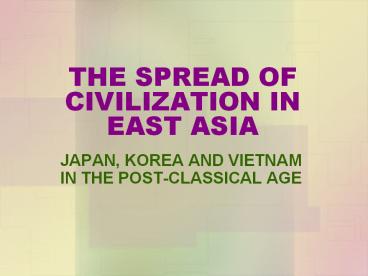THE SPREAD OF CIVILIZATION IN EAST ASIA - PowerPoint PPT Presentation
Title:
THE SPREAD OF CIVILIZATION IN EAST ASIA
Description:
Title: THE SPREAD OF CIVILIZATION IN EAST ASIA Author: Paul Philp Last modified by: Paul Philp Created Date: 11/27/2005 9:56:52 PM Document presentation format – PowerPoint PPT presentation
Number of Views:144
Avg rating:3.0/5.0
Title: THE SPREAD OF CIVILIZATION IN EAST ASIA
1
THE SPREAD OF CIVILIZATION IN EAST ASIA
- JAPAN, KOREA AND VIETNAM IN THE POST-CLASSICAL AGE
2
GEOGRAPHY INFLUENCES HISTORY
- Relative Location
- Korea, Vietnam border China
- Japan located off coast of East Asia
- Physical Characteristics
- Korea, Vietnam
- Mountainous, cut by river valleys
- Population located on plains
- Japan
- Volcanic islands, very mountainous
- Deep valleys with plains
- Demography
- Populace generally heavy on plains
- Rice was principal crop
- Cities exist but rarer than China
- Cities centers of Chinese culture
- Countryside resistant to Sinification
3
THE CONFUCIAN WORLD
4
KOREA THE BRIDGE
- Korea in the Ancient and Classical Periods
- Influenced by developments in China
- Chinese armies invaded periodically
- Chinese established control of parts of Korea
- Nomadic invasions frequent
- Fall of Han left regional Korean aristocrats in
control - Korean History 669 1392 C.E.
- Tang armies conquered much of Korea
- Silla dynasty allied with Tang, ruled peninsula
- Entered into a tributary relationship with China
- Song replaced Tang
- Koguryo conquered Silla in 935, ruled to 1392
- China's influence in Korea
- Sinification becoming Chinese
- Koreans borrowed what was useful, unavoidable
avoided what was not - Tributary embassies included Korean royal
officials and scholars - Silla kings built new capital at Kumsong modeled
on the Tang capital - Older Traditions
- Ancestor worship strong in Korean society
5
VIETNAM A BORDER STATE
- Nam Viet people originated in Southern China
- Rise of Han and southern settlement of Chinese
pushed Viet out - Viet migrated into Red River Valley, down coast
fighting local inhabitants - Vietnam under Chinese rule to c. 983 CE
- Han first conquered Northern Vietnam in 111 BCE
- Viet elites adopted Chinese agriculture, schools,
thought intermarried - Massive migration of Chinese official, scholars,
bureaucrats to Vietnam - Trung sisters led revolt against Chinese rule (40
43 CE) - Peasants resented Chinese influence, role of
towns, cities - 1,000 year struggle for independence
- Relationship often tributary to China
- Independent Vietnam (c. 983 CE)
- Ruled by Dynasties, capital moved between Hanoi,
Hue - Constant pressure against hill peoples, pushing
south - Difference from China
- Role of village equal to role of family in China
- Few cities village dominate countryside, elders
ran villages - Many Vietnamese retained their religious
traditions - Women played more prominent roles in Vietnam
6
EARLY JAPAN
- Ancient Japan
- Earliest inhabitants were nomadic Caucasians
(Ainu) from Northeast Asia - Japanese related to Koreans, migrated into
islands, pushed Ainu north - Ruled by several dozen states dominate by clans,
1st millennium BCE - Shinto Ancestor veneration with deification of
nature, spirits (kami) - Nara Japan (710-794 C.E.)
- Inspired by Tang, Yamato clan claimed imperial
authority - The imperial court modeled on that of the Tang
- Built a new capital (Nara) in 710 C.E., modeled
on Chang'an - Prince Shotoku wrote first Japanese constitution
- Adopted Confucianism and Buddhism, but maintained
Shinto - Heian Japan (794-1185 C.E.)
- Moved to new capital Heian (modern Kyoto) in 794
- Japanese emperors as ceremonial figureheads and
symbols of authority - Effective power in the hands of the Fujiwara
family - Emperor did not rule
- Lived in splendid isolation along with court
elite - Effected by bureaucrats, complex etiquette
- Chinese learning dominated Japanese education,
culture
7
MEDIEVAL JAPAN
- Japanese feudalism
- Called the Shogunate Period
- Military dictators ruled, Emperors reigned in
splendid isolation - Government was centralized feudalism
- Countryside divided up into fiefs
- Daimyo appointed by the shoguns
- Adopted Neo-Confucianism as state philosophy
- Provincial lords controlled Japan
- Called Daimyo, vied for power against each other
- Constant war to increase personal power, wealth,
fiefs - Kamakura Period (1185-1333 C.E.)
- Muromachi Period (1336-1573 C.E.)
- The Samurai
- The lowest class of aristocratic nobility
- Professional warriors of provincial lords
- Observed samurai code called bushido
- Valued loyalty, military talent, and discipline
traded military skills for food - To preserve their honor, engaged in ritual
suicide called seppuku - Japanese Women
8
FIEFS OF FEUDAL JAPAN































